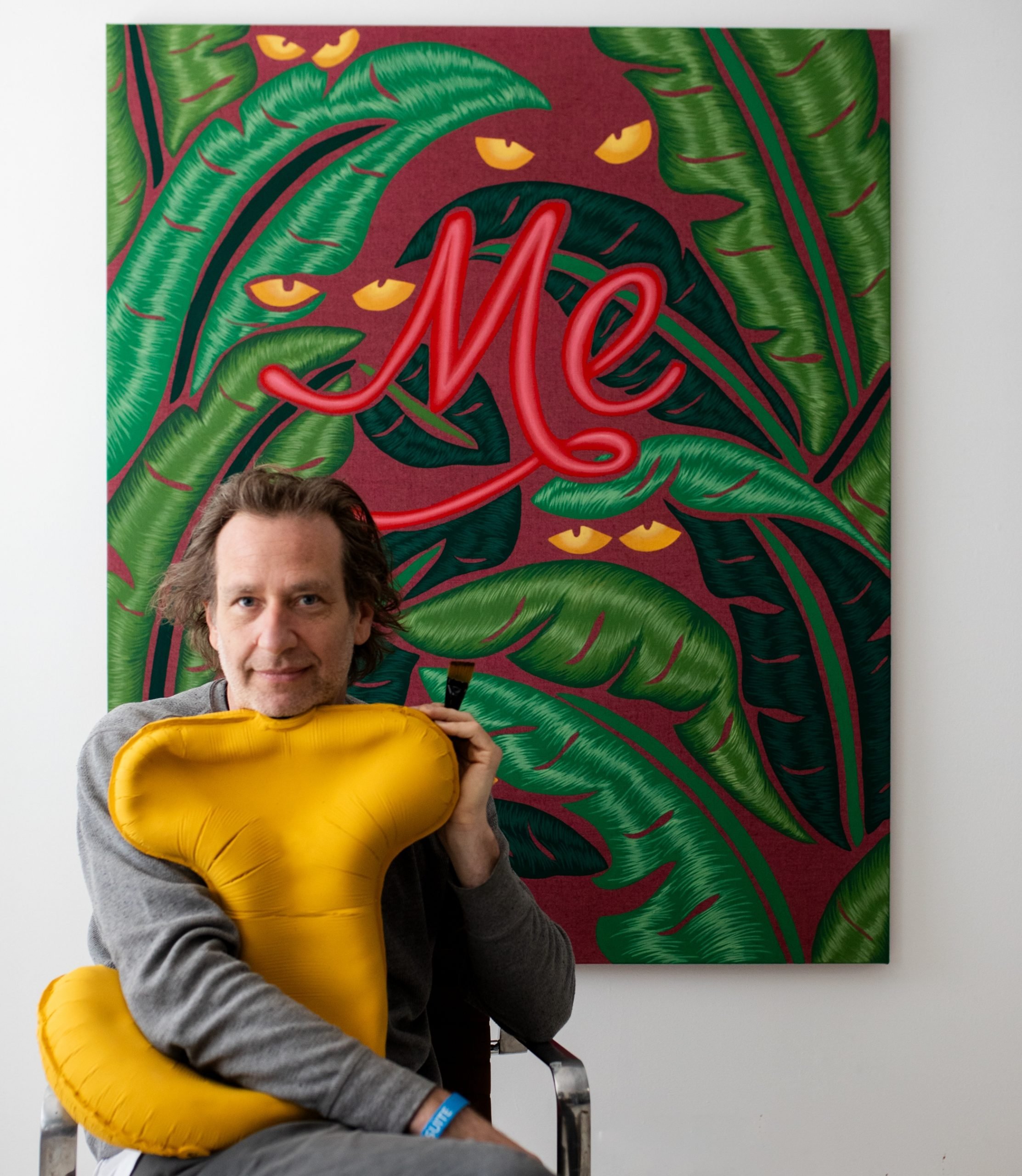
The beach ball embodies a sense of carefree exuberance, signaling that fun and games are afoot in a classic holiday setting. This object, emblazoned with words like “joy,” “us,” or “sunrise,” is dotted across three new exhibitions by the California-born, New York-based artist Joel Mesler: his “Pool Party” at Rockefeller Plaza, a solo show at Lévy Gorvy Dayan, also in New York, and “me, you and the sunset,” at Château La Coste in Aix-en-Provence, France.
But all is not quite as it seems, as is so often the way with shiny surfaces. Reach out to touch one of these apparently buoyant beach balls and, where you might expect it to give, your fingers will meet a taut bronze exterior. Inviting illusions that conceal something more weighty can be found throughout Mesler’s work, much of which is plastered over with apparently bland sentimentalisms like “love” and “hope.”
At Château La Coste, these words hover over luscious tropical greenery populated by animals like flamingos or snakes, or other seemingly random motifs like Hershey’s Kisses. These contain references to the artist’s past traumas, from being forced to squat in his own home after his parents’ divorce to his struggles with addiction. Mesler has spoken, for example, of how, in the midst of his father’s mental breakdown, he anxiously scratched the leafy wallpaper at the Beverly Hills Hotel until green pigment came off in his fingernails. It’s a moment he returns to again and again in his most verdant paintings. The highly evocative potential of buried memory has kept Mesler far away from the West Coast haunts he frequented while growing up, though their spirit remains everywhere in his work.
Joel Mesler’s “me you and the sunset” installed at Château La Coste in Aix-en-Provence in France. Photo: François Deladerriere, courtesy of the artist and David Kordansky Gallery.
“I can’t go back,” Mesler, 50, told me at the exhibition’s opening. “I have flashbacks.” By contrast, his new life on Long Island, following a stint in Manhattan, is associated with “sobriety, cleanliness, and clarity.”
With his mindset clearly affected by his location, Mesler was pleasantly surprised by a visit to Château La Coste last summer. The vast, ever-expanding complex encompasses two luxury hotels, sprawling vineyards, five art galleries, and some 20 pieces of permanently installed public sculpture by artists like Louise Bourgeois, Tracey Emin, Sean Scully, and Richard Serra. Mesler had gone to see a show by his friend Jennifer Guidi, and found that the sun-drenched rolling landscape transported him back to California without having to revisit any of its darker associations.
“It was the first time that I actually felt I could be present with the light and the space, both things I loved about Los Angeles, without any of my own craziness,” he said.
The Richard Rogers Gallery, where the works are installed, is a glass box that cantilevers 88 feet out of a hillside. Mesler has responded to its impressive views by dyeing the linen grounds on his paintings with shades that mimic the sky’s shift from bright midday blue to purple-tinged sunset.
Joel Mesler’s “me, you and the sunset” installed at Château La Coste in Aix-en-Provence in France. Photo: François Deladerriere, courtesy of the artist and David Kordansky Gallery.
A longtime inspiration for Mesler is Ed Ruscha, another artist who uses text in his work and whom Mesler describes as “a cool cowboy from Oklahoma” in contrast to his own “soft, cuddly Jew from Los Angeles.” For this reason, Ruscha got away with imbuing his work with an edge that “could be clever, could be snarky, could be sardonic.” Meanwhile, Mesler conceded, his more saccharine text could easily verge into Hallmark territory.
“I’m always doing that dance with whether its too much,” he said. “It’s never too little. I like to play with that space. I’m trying to do things where I’m driven by my heart.”
Mesler comes across more wry and world-weary than his art might suggest, but he’s had a lot of time to think about the message he wants to put across. His path into his current practice was an unusual one, featuring a near two-decade detour during which he worked predominantly as an art dealer in Los Angeles and later New York City, promoting artists like Henry Taylor and Rashid Johnson. Mesler’s original intention to be an artist himself—he trained at the San Francisco Art Institute—was squashed after he failed to find much early success.
Joel Mesler’s “Pool Party” at the Rockefeller Plaza in New York City. Photo courtesy of Tishman Speyer.
He attributes this to the “angry” and “aggressive” nature of his expressionistic early works, which alienated their audience. “I tried to yell at people,” said Mesler. “I wanted people to notice how wronged I felt by the world. That’s not a way to connect and share. Anytime that someone is willing to be vulnerable, it allows other people to be vulnerable too. It creates a space of openness. The things I used to hide and was ashamed about are the first things I expose about myself. I have nothing to hide anymore.”
“People might say ‘love’ isn’t the deepest thing they’ve ever heard,” he said, referring back to more recent works, like those at Château La Coste. “I would say, I’ve never been able to actually access love in my life until very recently. The fact that someone like me can even appreciate a word like ‘love’ is a miracle in and of itself. To me it means something very significant, so I’m telling my story and some people might resonate with it.”
“Me, you and the sunset” is on view in the Richards Rogers Gallery at Château La Coste until September 8. “Joel Mesler: Kitchens are good rooms to cry in” is at Lévy Gorvy Dayan in New York through July 26. The artist’s “Pool Party” remains installed at Rockefeller Center until July 21.